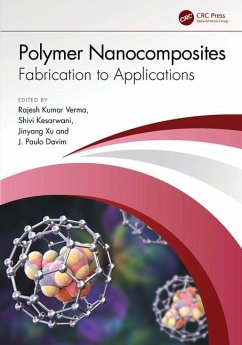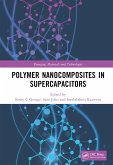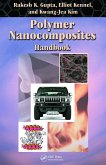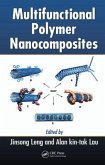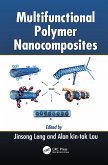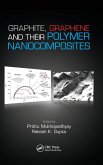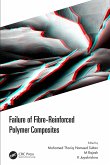Polymer Nanocomposites
Fabrication to Applications
Herausgeber: Verma, Rajesh Kumar; Xu, Jinyang; Kesarwani, Shivi
Polymer Nanocomposites
Fabrication to Applications
Herausgeber: Verma, Rajesh Kumar; Xu, Jinyang; Kesarwani, Shivi
- Gebundenes Buch
- Merkliste
- Auf die Merkliste
- Bewerten Bewerten
- Teilen
- Produkt teilen
- Produkterinnerung
- Produkterinnerung
Polymer Nanocomposites: Fabrication to Applications offers readers an up-to-date interpretation of various polymeric nanocomposite materials and technologies via critical reviews. It covers developments and advancements in various nanomaterials, polymeric materials, biopolymers, and processes. It initiates from nanomaterial synthesis, fabrication, and characterization to the manufacturing aspect and feasible product applications of polymer-based nanocomposites. The prime focus is on polymer matrix nanocomposites and their future trends in the engineering sector. Features: Explores synthesis,…mehr
Andere Kunden interessierten sich auch für
![Polymer Nanocomposites in Supercapacitors Polymer Nanocomposites in Supercapacitors]() Polymer Nanocomposites in Supercapacitors194,99 €
Polymer Nanocomposites in Supercapacitors194,99 €![Polymer Nanocomposites Handbook Polymer Nanocomposites Handbook]() Polymer Nanocomposites Handbook247,99 €
Polymer Nanocomposites Handbook247,99 €![Multifunctional Polymer Nanocomposites Multifunctional Polymer Nanocomposites]() Multifunctional Polymer Nanocomposites271,99 €
Multifunctional Polymer Nanocomposites271,99 €![Multifunctional Polymer Nanocomposites Multifunctional Polymer Nanocomposites]() Multifunctional Polymer Nanocomposites109,99 €
Multifunctional Polymer Nanocomposites109,99 €![Graphite, Graphene, and Their Polymer Nanocomposites Graphite, Graphene, and Their Polymer Nanocomposites]() Graphite, Graphene, and Their Polymer Nanocomposites261,99 €
Graphite, Graphene, and Their Polymer Nanocomposites261,99 €![Failure of Fibre-Reinforced Polymer Composites Failure of Fibre-Reinforced Polymer Composites]() Failure of Fibre-Reinforced Polymer Composites195,99 €
Failure of Fibre-Reinforced Polymer Composites195,99 €![Metal Nanocomposites in Nanotherapeutics for Oxidative Stress-Induced Metabolic Disorders Metal Nanocomposites in Nanotherapeutics for Oxidative Stress-Induced Metabolic Disorders]() Metal Nanocomposites in Nanotherapeutics for Oxidative Stress-Induced Metabolic Disorders215,99 €
Metal Nanocomposites in Nanotherapeutics for Oxidative Stress-Induced Metabolic Disorders215,99 €-
-
-
Polymer Nanocomposites: Fabrication to Applications offers readers an up-to-date interpretation of various polymeric nanocomposite materials and technologies via critical reviews. It covers developments and advancements in various nanomaterials, polymeric materials, biopolymers, and processes. It initiates from nanomaterial synthesis, fabrication, and characterization to the manufacturing aspect and feasible product applications of polymer-based nanocomposites. The prime focus is on polymer matrix nanocomposites and their future trends in the engineering sector. Features: Explores synthesis, characterization, properties, fabrication/processing, and applications of polymer nanocomposite materials Elaborates on polymer manufacturing phase challenges using various control methods and statistical tools and modules Includes machining and micro (¿) machining investigation on the polymer nanocomposites Discusses modeling, simulation, and optimization of process parameters during the machining processes and applications of additive manufacturing Comprehends the significance of nanomaterials functionalizing synthetic fibrous and biocompatible composites This book is aimed at researchers and graduate students in mechanical engineering, materials science, polymers, composites, and nanomaterials.
Hinweis: Dieser Artikel kann nur an eine deutsche Lieferadresse ausgeliefert werden.
Hinweis: Dieser Artikel kann nur an eine deutsche Lieferadresse ausgeliefert werden.
Produktdetails
- Produktdetails
- Verlag: CRC Press
- Seitenzahl: 322
- Erscheinungstermin: 11. September 2023
- Englisch
- Abmessung: 260mm x 183mm x 22mm
- Gewicht: 803g
- ISBN-13: 9781032381954
- ISBN-10: 1032381957
- Artikelnr.: 68102438
- Herstellerkennzeichnung
- Libri GmbH
- Europaallee 1
- 36244 Bad Hersfeld
- gpsr@libri.de
- Verlag: CRC Press
- Seitenzahl: 322
- Erscheinungstermin: 11. September 2023
- Englisch
- Abmessung: 260mm x 183mm x 22mm
- Gewicht: 803g
- ISBN-13: 9781032381954
- ISBN-10: 1032381957
- Artikelnr.: 68102438
- Herstellerkennzeichnung
- Libri GmbH
- Europaallee 1
- 36244 Bad Hersfeld
- gpsr@libri.de
Rajesh Kumar Verma is a professor in the Department of Mechanical Engineering, School of Engineering at Harcourt Butler Technical University, Kanpur, India. It is a renowned and old premier institute whose roots are as deep as its outlook. The Government Research Institute, Cawnpore was established in 1920 and was renamed "Government Technological Institute" in 1921. Finally, in 1926, it got the name we know today, "Harcourt Butler Technological Institute." As per Act No. 11 of 2016 by the Government of Uttar Pradesh, it has become a university, i.e., Harcourt Butler Technical University Kanpur, India. Prof. Verma received his Ph.D. (engineering) from Jadavpur University, Kolkata, India. He is a C.Eng. (mechanical engineering) of the Institution of Engineers (India). He is actively involved in teaching and research in waste management, fiber science, composites, nanomaterial, modeling, simulation, optimization, and manufacturing processes. Prof. Verma currently supervised/ongoing more than 13 master's and nine Ph.D. theses and published more than 135 research articles in peer-reviewed journals and conferences. The e-content and courses he developed are widely used in the Indian university system. He has completed/ongoing more than eight research and development (R&D) projects sponsored by various govt. agencies such as SERB-DST, AICTE, CST, MHRD, etc. He is now a reviewer of various international publishers. Moreover, Prof. Verma has been invited as keynote/invited speaker, section chair, and member for several international conferences with themes in mechanical and production engineering, emerging materials, and manufacturing science. He has developed various nanomaterials for structural applications and proposed hybrid optimization modules recognized by multiple peer-reviewed journal publishers. Shivi Kesarwani is currently working as a senior research assistant in the Department of Mechanical Engineering at Madan Mohan Malaviya University of Technology, India. He is an associate member of the Institution of Engineers (India). His research interests are nanomaterial synthesis and development, composites machining, numerical modeling, and surface texturing. He has published over 30+ peer-reviewed articles in refereed international journals and conference proceedings. Additionally, he has filed two process and two design patents and has one Indian copyright-registered document. He has also utilized various nanomaterial-reinforced fibrous composites for structural applications and developed hybrid metaheuristic optimizing methodologies recognized by multiple peer-reviewed journals and book publishers. Jinyang Xu is an Associate Professor and a Doctoral Supervisor of Mechanical Engineering at Shanghai Jiao Tong University, China. He received his Ph.D. (2016) in Mechanical Engineering from Arts et Métiers ParisTech, France. His research interests focus on composites machining, numerical modeling, micro/nano cutting, and surface texturing. He has published over 100 articles in highly-ranked JCR-referenced journals as a first/corresponding author, and edited 2 monographs, 5 book chapters, 6 int. conf. proceedings & 8 special issues. He now serves as the Editor-in-Chief of Journal of Coating Science and Technology (JCST), International Journal of Precision Technology (IJPTech), and International Journal of Product Sound Quality (IJPSQ). He is an Associate Editor of Proc. Inst. Mech. Eng. Pt. E - J. Process. Mech. Eng. (SCIE/EI), Simulation-Transactions of the Society for Modeling and Simulation International (SCIE/EI), and Frontiers in Materials (SCIE/EI). Presently, he is an Editorial Board Member of 7 SCI journals, including Green Materials, Journal of Superhard Materials, International Journal of Aerospace Engineering, Coatings, Lubricants, etc. He was honored with the prestigious IAAM Scientist Medal of the year 2020, and awarded the Shanghai Pujiang Scholar by the Shanghai Municipality in 2017. He is a fellow of IAAM and also a senior member of ASME and SCS. J. Paulo Davim is a full professor at the University of Aveiro, Portugal. He is also distinguished as honorary professor in several universities/colleges in China, India, and Spain. He received his Ph.D. degree in mechanical engineering in 1997, M.Sc. degree in mechanical engineering (materials and manufacturing processes) in 1991, mechanical engineering degree in 1986 from the University of Porto (FEUP), the aggregate title (full habilitation) from the University of Coimbra in 2005, and D.Sc. (higher doctorate) from London Metropolitan University in 2013. He is a Senior Chartered Engineer by the Portuguese Institution of Engineers with an MBA and specialist titles in engineering and industrial management as well as in metrology. He is also Eur Ing by FEANI-Brussels and Fellow (FIET) of IET-London. He has more than 30 years of teaching and research experience in manufacturing, materials, mechanical, and industrial engineering, with a special emphasis on machining and tribology. He has also interest in management, engineering education, and higher education for sustainability. He has guided large numbers of postdoc, Ph.D., and master's students as well as has coordinated and participated in several financed research projects. He has received several scientific awards and honors. He has worked as an evaluator of projects for the European Research Council and other international research agencies as well as the examiner of Ph.D. thesis for many universities in different countries. He is the editor in chief of several international journals, guest editor of journals, book editor, book series editor, and scientific advisory for many international journals and conferences. Presently, he is an editorial board member of 30 international journals and acts as a reviewer for more than 100 prestigious Web of Science journals. In addition, he has also published as editor (and co-editor) more than 200 books and as author (and co-author) more than 15 books, 100 book chapters, and 500 articles in journals and conferences (more than 300 articles in journals indexed in Web of Science core collection/h-index 61+/12000+ citations, SCOPUS/h-index 65+/15000+ citations, Google Scholar/h-index 84+/25000+ citations). He has listed in World's Top 2% Scientists by Stanford University study.
Chapter 1 A Brief Overview of Polymer Composites and Nanocomposites
Chapter 2 Nano-Engineered Polymer Matrix-Based Composites
Chapter 3 Electrospun Polymer Nanofibers in Catalysis for Pollutant Removal
Chapter 4 Nanoengineered Polymer Composites and Their Applications: A
Systematic Assessment of Synthesis Methods
Chapter 5 Polymer Nanocomposites for Energy Harvesting
Chapter 6 Nanophytomedicine and Their Applications: A Brief Overview
Chapter 7 Polymer Nanocomposite Coatings: Characterisation Techniques and
Applications
Chapter 8 Recent Trends in Nanometric Dispersed Polymer Composites
Chapter 9 Dispersive Techniques and Methods to Synchronize Host-Guest
Interactionsof Nanocomposite-Reinforced Polymers
Chapter 10 Application of Nanoparticle-Reinforced Polymeric Composites in
Bioscience and Medicinal Disciplines: A Review
Chapter 11 Bionanocomposites: Biological Aspects and Biomedical
Applications
Chapter 12 Strategies to Improve the Micro-electrical Discharge Machining
Performance of CFRP
Chapter 13 Polycarbonate (PC)-Based Material Design and Investigation of
its Properties by Fused Deposition Modeling (FDM)
Chapter 14 Mechanics of Composite Material Machining: An Overview
Chapter 15 Fabrication and Machinability (Drilling) Properties of Fiber
Metal Laminate (FML) Composites (CARALL and GLARE)
Chapter 16 Micromachining of Polymer Composites and Nanocomposites
Chapter 17 Grinding Nanocomposite Materials for Space Applications
Chapter 18 Future Trends in Polymer Nanocomposites
Chapter 2 Nano-Engineered Polymer Matrix-Based Composites
Chapter 3 Electrospun Polymer Nanofibers in Catalysis for Pollutant Removal
Chapter 4 Nanoengineered Polymer Composites and Their Applications: A
Systematic Assessment of Synthesis Methods
Chapter 5 Polymer Nanocomposites for Energy Harvesting
Chapter 6 Nanophytomedicine and Their Applications: A Brief Overview
Chapter 7 Polymer Nanocomposite Coatings: Characterisation Techniques and
Applications
Chapter 8 Recent Trends in Nanometric Dispersed Polymer Composites
Chapter 9 Dispersive Techniques and Methods to Synchronize Host-Guest
Interactionsof Nanocomposite-Reinforced Polymers
Chapter 10 Application of Nanoparticle-Reinforced Polymeric Composites in
Bioscience and Medicinal Disciplines: A Review
Chapter 11 Bionanocomposites: Biological Aspects and Biomedical
Applications
Chapter 12 Strategies to Improve the Micro-electrical Discharge Machining
Performance of CFRP
Chapter 13 Polycarbonate (PC)-Based Material Design and Investigation of
its Properties by Fused Deposition Modeling (FDM)
Chapter 14 Mechanics of Composite Material Machining: An Overview
Chapter 15 Fabrication and Machinability (Drilling) Properties of Fiber
Metal Laminate (FML) Composites (CARALL and GLARE)
Chapter 16 Micromachining of Polymer Composites and Nanocomposites
Chapter 17 Grinding Nanocomposite Materials for Space Applications
Chapter 18 Future Trends in Polymer Nanocomposites
Chapter 1 A Brief Overview of Polymer Composites and Nanocomposites
Chapter 2 Nano-Engineered Polymer Matrix-Based Composites
Chapter 3 Electrospun Polymer Nanofibers in Catalysis for Pollutant Removal
Chapter 4 Nanoengineered Polymer Composites and Their Applications: A
Systematic Assessment of Synthesis Methods
Chapter 5 Polymer Nanocomposites for Energy Harvesting
Chapter 6 Nanophytomedicine and Their Applications: A Brief Overview
Chapter 7 Polymer Nanocomposite Coatings: Characterisation Techniques and
Applications
Chapter 8 Recent Trends in Nanometric Dispersed Polymer Composites
Chapter 9 Dispersive Techniques and Methods to Synchronize Host-Guest
Interactionsof Nanocomposite-Reinforced Polymers
Chapter 10 Application of Nanoparticle-Reinforced Polymeric Composites in
Bioscience and Medicinal Disciplines: A Review
Chapter 11 Bionanocomposites: Biological Aspects and Biomedical
Applications
Chapter 12 Strategies to Improve the Micro-electrical Discharge Machining
Performance of CFRP
Chapter 13 Polycarbonate (PC)-Based Material Design and Investigation of
its Properties by Fused Deposition Modeling (FDM)
Chapter 14 Mechanics of Composite Material Machining: An Overview
Chapter 15 Fabrication and Machinability (Drilling) Properties of Fiber
Metal Laminate (FML) Composites (CARALL and GLARE)
Chapter 16 Micromachining of Polymer Composites and Nanocomposites
Chapter 17 Grinding Nanocomposite Materials for Space Applications
Chapter 18 Future Trends in Polymer Nanocomposites
Chapter 2 Nano-Engineered Polymer Matrix-Based Composites
Chapter 3 Electrospun Polymer Nanofibers in Catalysis for Pollutant Removal
Chapter 4 Nanoengineered Polymer Composites and Their Applications: A
Systematic Assessment of Synthesis Methods
Chapter 5 Polymer Nanocomposites for Energy Harvesting
Chapter 6 Nanophytomedicine and Their Applications: A Brief Overview
Chapter 7 Polymer Nanocomposite Coatings: Characterisation Techniques and
Applications
Chapter 8 Recent Trends in Nanometric Dispersed Polymer Composites
Chapter 9 Dispersive Techniques and Methods to Synchronize Host-Guest
Interactionsof Nanocomposite-Reinforced Polymers
Chapter 10 Application of Nanoparticle-Reinforced Polymeric Composites in
Bioscience and Medicinal Disciplines: A Review
Chapter 11 Bionanocomposites: Biological Aspects and Biomedical
Applications
Chapter 12 Strategies to Improve the Micro-electrical Discharge Machining
Performance of CFRP
Chapter 13 Polycarbonate (PC)-Based Material Design and Investigation of
its Properties by Fused Deposition Modeling (FDM)
Chapter 14 Mechanics of Composite Material Machining: An Overview
Chapter 15 Fabrication and Machinability (Drilling) Properties of Fiber
Metal Laminate (FML) Composites (CARALL and GLARE)
Chapter 16 Micromachining of Polymer Composites and Nanocomposites
Chapter 17 Grinding Nanocomposite Materials for Space Applications
Chapter 18 Future Trends in Polymer Nanocomposites

